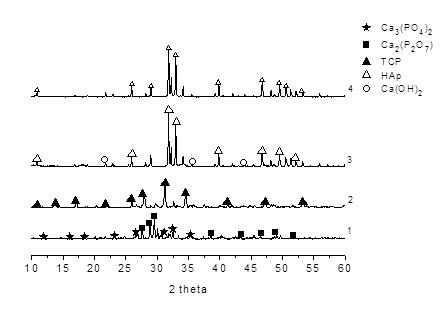Recently, significant progress in the field of biomaterials used as implant material which include calcium phosphate ceramics such as hydroxyapatite (HAp), α-tricalcium phophate (α-TCP), β-tricalcium phophate (β-TCP) and biphasic mixtures (BCPs) is observed. Ca/P molar ratio, the purity of the materials and the variable synthesis conditions can significantly affect the behavior of these ceramics during in vitro and in vivo testing.
The main objective of this work was attainment and characterization of biphasic ceramics with variable Ca/P molar ratios. Natural origin calcium phosphates (HAp) used in this study were derived mainly from pork bones and were modified with addition of phosphoric acid or calcium oxide to attain forms with Ca/P molar ratio equal 1; 1,5 and 2 respectively. Phase composition and structural analyses of natural hydroxyapatites and their modifications with variable Ca/P molar ratios were performed by means of XRD Diffractometry. Content of calcium and phosphorus in calcium phosphate materials were determined according to polish standards denoted as PN-97/R-64803 and PN-80/C-87015 respectively.
Received specimens with particular Ca/P molar ratios were physicochemically analyzed in order to determine accurate Ca/P ratios, and the main outcome of the studies is summarized in Table 1.
Table 1. Ca/P molar ratios in analyzed calcium phosphates

Figure 1 exemplify the results of XRD analysis of the calcium phosphates with variable Ca/P ratios. First line denoted as 1 refers to Ca/P ratio equal 1 and indicates formation of two phases of Ca2(P2O7) and Ca3(PO4)2. Line 2 with Ca/P ratio equal 1,5 is characterized by presence of TCP structure and is shifted towards lower values of 2 theta in comparison with pure natural hydroxyapatite (line 4). The modification of Ca/P=2 marked as line 3 indicates the presence of HAp and Ca(OH)2 phases and lies in the same values of 2 theta as the natural HAp expressed by line 4.

Figure 1. XRD spectra of natural HAP and its modifications with variable Ca/P ratios where lines correspond to 1-Ca/P=1,0; 2-Ca/P=1,5; 2-Ca/P=2,0; 4-natural HAp
In summary biphasic HAp-TCP ceramics with various Ca/P molar ratios constitute valuable materials for bomedical application.
This work was financed by the National Centre for Research and Development under the Lider project contract no. 037/481/L-5/13/NCBR/2014
References:
[1] Marchi J., Ribeiro Ch., Bressiani A.H., Marques M.M., Mat. Res. vol.16 no.4 São Carlos 2013.